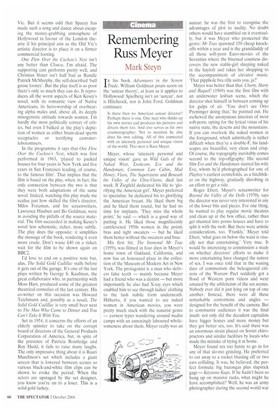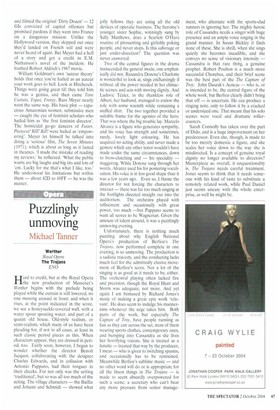Russ Meyer
Mark Steyn
In his book Adventures in the Screen Trade. William Goldman pours scorn on the `auteur theory', at least as it applies to Hollywood: Spielberg isn't an `auteur', nor is Hitchcock, nor is John Ford. Goldman continues:
Is there then no American auteur director? Perhaps there is one. One man who thinks up his own stories and produces his pictures and directs them too. And also serves as his own cinematographer. Not to mention he also does his own editing. All of this connected with an intensely personal and unique vision of the world. That man is Russ Meyer.
Meyer. whose 'intensely personal and unique vision' gave us Wild Gals of the Naked West, Eroticom, Eve and the Handyman, Common Law Cabin, Mud Honey, Vixen, The Supervixens and Beneath the Valley of the Ultra-Vixens, died last week. If Ziegfeld dedicated his life to 'glorifying the American girl', Meyer preferred to specialise: he dedicated his to glorifying the American breast. He liked them big and he liked them round, but he had no time for implants. 'They miss the whole point,' he said — which is a good way of putting it. He liked those magnificently cantilevered 1950s women in the pointy bras and tight sweaters — but he liked them better without the sweaters and bras.
His first hit, The Immoral Mr Teas (1959), was filmed in four days in Meyer's home town of Oakland. California, and now has an honoured place in the collection of the Museum of Modern Art in New York. The protagonist is a man who delivers false teeth — mainly because Meyer had a friend who was a dentist — but more importantly he also had X-ray eyes which enabled him to see through ladies' clothing to the lush nubile form underneath. Hitherto, if you wanted to see naked women in American movies, you were pretty much stuck with the naturist genre — earnest types wandering around nudist camps with an annoyingly laboured wholesomeness about them. Meyer really was an
auteur: he was the first to recognise the advantages of plot to nudity. No doubt others would have stumbled on it eventually, but it was Meyer who pioneered the genre: Mr Teas spawned 150 cheap knockoffs within a year and is the granddaddy of all those soft-porn Euro-movies of the Seventies where the bisexual countess discovers the new stable-girl sleeping naked in the hayloft and takes her shopping to the accompaniment of elevator music. 'That pipphole bra rilly suits you, ja?'
Meyer was better than that. Cherry. Harri. and Raquel! (1969) was the first film with an underwater lesbian scene, which the director shot himself in between coming up for gulps of air. 'You don't see Otto Preminger doing that,' he pointed out. He eschewed the anonymous interiors of most soft-porn, opting for the lyrical vistas of his native state, the deserts and the mountains. If you can overlook the naked women in the foreground, which admittedly is rather difficult when they're a double-F, his landscapes are beautiful, very clean and crisp. Of course, the topography inevitably comes second to the top-offgraphy: His second film Eve and the Handyman starred his wife Eve, whom he'd photographed for one of Playboy's earliest centrefolds, as a hitchhiker on the highway, gradually disrobing in an effort to get a ride.
Roger Ebert, Meyer's screenwriter for Beyond the Valley of the Dolls (1970), says the director was never very interested in any of the lower bits and pieces. For one thing, he wanted to play regular movie theatres and clean up at the box office, rather than get shunted into porno houses and have to split it with the mob. But there were artistic considerations, too. 'Frankly,' Meyer told Ebert, 'what goes on below the waist is visually not that entertaining.' Very true. It would be interesting to commission a study on whether directors' efforts to make it more entertaining have changed the nature of sex. I was once told that in the waning days of communism the beleaguered citizens of the Warsaw Pact suddenly got a flood of Western porn videos and were amazed by the athleticism of the sex scenes. Nobody ever did it just lying on top of one another. Instead, there were all these remarkable contortions and angles — designed for the benefit of the camera. But to communist audiences it was the final insult: not only did the decadent capitalists have bigger homes and more money but they got better sex, too. It's said there was an enormous strain placed on Soviet chiropractors and similar facilities by locals who made the mistake of trying it at home.
Meyer found sex too funny to go in for any of that slo-mo grinding. He preferred to cut away to a rocket blasting off or two cars colliding. It was, he believed, the perfect formula: big bazongas plus slapstick gags — Keystone Kups, If he hadn't been so hung up on massive racks, what might he have accomplished? Well, he was an army photographer during the second world war and filmed the original 'Dirty Dozen' — 12 GIs convicted of capital offences but promised pardons if they went into France on a dangerous mission. Unlike the Hollywood version, they skipped out once they'd landed on French soil and were never heard of again. But Meyer had a hell of a story and got a credit in E.M. Nathanson's novel of the incident. He loathed Robert Aldrich's 1967 movie.
William Goldman's own 'auteur theory' holds that once you're hailed as an auteur your work goes to hell. Look at Hitchcock. Things were going great till they told him he was a genius, and then came Torn Curtain, Topaz, Frenzy. Russ Meyer nearly went the same way. His basic plot — rapacious Amazonian women, submissive men — caught the eye of feminist scholars who hailed him as 'the first feminist director'. The homicidal go-go dancers of Faster, Pussycat! Kill! Kill! were hailed as 'empowering'. Meyer let himself be talked into doing a 'serious' film, The Seven Minutes (1971), which is about as long as it lasted in theatres. 'I made the mistake of reading my reviews,' he reflected. 'What the public wants are big laughs and big tits and lots of 'em. Lucky for me that's what I like, too.' He understood his limitations but within them — about 42D to 48FF — he was the master.



















































































 Previous page
Previous page